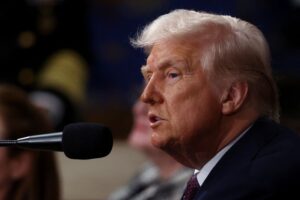Analyzing the Implications of Trump’s Unconventional Strategies to Tackle U.S. Debt
As the U.S. grapples with an ever-increasing debt magnitude, which currently stands at around $36 trillion—over 120% of the nation’s annual GDP—investors are keenly observing the unconventional approaches being proposed by the Trump administration. There’s growing concern about the sustainability of such debt levels, especially with the last fiscal year’s deficit exceeding 6% of GDP. While many might have anticipated cuts to popular health and retirement benefits to mitigate these numbers, Trump has undeniably signaled otherwise.
Out-of-the-Box Proposals Making Waves in Financial Circles
Recent discussions among Trump’s economic advisers reveal a host of unconventional ideas aimed at reducing the deficit, such as proposing the exchange of U.S. Treasury securities for lower-cost bonds held by foreign governments. Additionally, the suggestion to sell U.S. residency cards to foreign investors at a price tag of $5 million has also been floated. But how viable are these suggestions, and what might they mean for the financial markets?
With rising reliance on Treasury bonds, the notion of a forced swap could stir unease, potentially impacting the U.S.’s creditworthiness. This strategy may backfire, undermining confidence in U.S. debt instruments and raising concern among investors, given the pivotal role that U.S. Treasury yields play in the broader financial ecosystem.
The Reality of Debt Management and Market Sentiment
Larry Summers, a prominent economist, emphasizes that manipulating long-term yields via unorthodox financial tactics is fraught with limitations. The consensus among several market analysts is that while innovative approaches might appear appealing, they may lack the efficacy to genuinely correct the underlying fiscal imbalance. Economic indicators portray this dilemma clearly; as interest rates on long-term U.S. debt dip recently, what is driving this divergence? Market participants like Niladri Mukherjee, Chief Investment Officer at TIAA Wealth Management, argue that uncertainty surrounding Trump’s policies fosters an environment conducive to economic stagnation or worse.
Investor Confidence and Economic Viability
The Trump administration’s Financial Efficiency initiative, cleverly billed as "DOGE" after Elon Musk’s popular cryptocurrency, aims to consolidate federal spending while implementation of heavy tariffs aims to generate additional revenue. Yet, as many economists have noted, the results remain uncertain—a sentiment echoed by the declining fortunes of the U.S. equity markets. The S&P 500 has suffered a decline of over 4% since Trump resumed office, juxtaposed against a mere 1.3% drop in an index of stocks from over 40 other nations.
Investors need tangible evidence that the administration’s steps towards fiscal stability are yielding positive results; otherwise, rising skepticism could trigger another sell-off in bonds, raising borrowing costs further and complicating the legislative agenda.
Creative Solutions on the Horizon
In November, economist Stephen Miran, named to head Trump’s Council of Economic Advisors, introduced the so-called "Mar-a-Lago Accord." This initiative proposes the idea of leveraging tariffs to persuade foreign governments to swap Treasury holdings for lower-cost century bonds, potentially mitigating annual interest liabilities by an estimated $100 billion. While substantial, this figure would only scratch the surface of the ballooning debt, projected to reach $52 trillion by 2035.
Another innovative proposal includes the "gold card" program—offering wealthy global investors residency rights, which Trump and Commerce Secretary Howard Lutnick contend could garner trillions to offset national debt. However, the reception of this plan has been lukewarm, as many advisors caution against the implications of U.S. taxation on global income.
Additionally, there’s even speculation about leveraging the country’s gold reserves, valued at approximately $758 billion against the Federal Reserve’s historical valuation of just $11 billion. Although discussions about monetizing this asset may bubble to the forefront, the practicality remains a subject of intense debate.
Reflecting on Trump’s Negotiating Acumen
With a formidable history in real estate, Trump’s approach towards managing the national debt could reflect the principles he applied in corporate restructuring. Observers note that his storied past of negotiating with banks during the 1990 financial crisis speaks to both resilience and adaptability.
While some critics may argue against the implementation of historic fiscal strategies, it’s crucial for investors and stakeholders alike to remain vigilant and flexible. The financial landscape is unpredictable, and under Trump, one must "expect the unexpected."
Final Thoughts
As we navigate this complex financial terrain, it’s essential to keep an eagle eye on the interplay between unconventional economic strategies and market confidence. At Extreme Investor Network, we are committed to providing in-depth analysis and expert insights to empower you, the investor, to make informed decisions—in a world where the only constant is change. Stay tuned for more updates as these strategies unfold, and remember, foresight is as crucial as insight in today’s dynamic market conditions.

